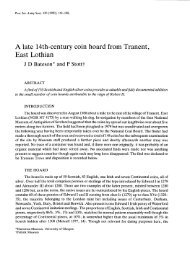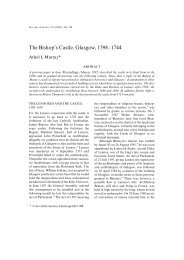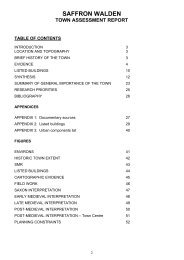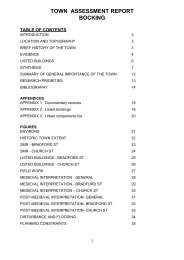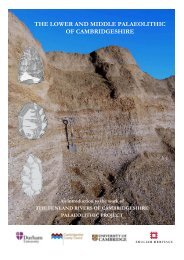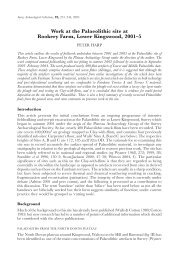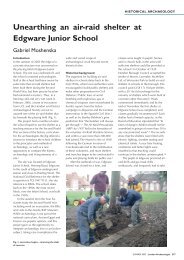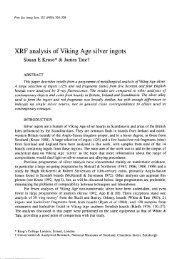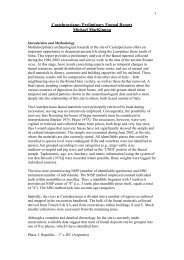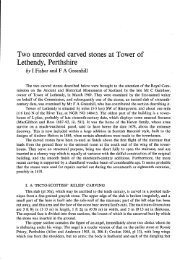The late Iron Age and Roman settlement at Leda Cottages, Westwell ...
The late Iron Age and Roman settlement at Leda Cottages, Westwell ...
The late Iron Age and Roman settlement at Leda Cottages, Westwell ...
Create successful ePaper yourself
Turn your PDF publications into a flip-book with our unique Google optimized e-Paper software.
CTRL Integr<strong>at</strong>ed Site Report Series <strong>Leda</strong> <strong>Cottages</strong>, <strong>Westwell</strong><br />
period n<strong>at</strong>ure, suggesting th<strong>at</strong> the site had seen periods of use from the <strong>l<strong>at</strong>e</strong> Mesolithic through<br />
to the <strong>Roman</strong> period. Two foci of activity were identified in the <strong>l<strong>at</strong>e</strong> <strong>Iron</strong> <strong>Age</strong> <strong>and</strong> early<br />
<strong>Roman</strong> periods. <strong>The</strong> first one included a concentric enclosure with associ<strong>at</strong>ed causeway,<br />
possibly for pastoral or agricultural purpose <strong>and</strong> various discrete fe<strong>at</strong>ures, including four-post<br />
structures. <strong>The</strong> second area comprised two industrial plots, suggestive of metalworking <strong>and</strong><br />
trade. <strong>The</strong> site appears to have ceased to be used around AD 250.<br />
Prior to the commencement of the CTRL construction, a series of evalu<strong>at</strong>ion trenches<br />
was excav<strong>at</strong>ed to the immedi<strong>at</strong>e west <strong>and</strong> south-east of the site. Museum of London<br />
Archaeological Services (MoLAS) excav<strong>at</strong>ed trial trenches <strong>at</strong> the back of <strong>Leda</strong> <strong>Cottages</strong><br />
(ARC LED98) (URS 1998a) which produced a solitary post-medieval pit.<br />
Work west of Leacon Lane (ARC LLA98) c 1.5 km to the west of the site, produced a<br />
concentr<strong>at</strong>ion of <strong>l<strong>at</strong>e</strong> Neolithic/early Bronze <strong>Age</strong> worked flint, seven und<strong>at</strong>ed pits, a probable<br />
early <strong>Roman</strong> ditch <strong>and</strong> a cluster of <strong>l<strong>at</strong>e</strong> <strong>Iron</strong> <strong>Age</strong>/early <strong>Roman</strong> pits. Two badly trunc<strong>at</strong>ed <strong>l<strong>at</strong>e</strong><br />
<strong>Iron</strong> <strong>Age</strong> pits were recorded east of Pluckley Road during the w<strong>at</strong>ching brief (ARC 430/99)<br />
(URS 2000a).<br />
Substantial evidence of <strong>l<strong>at</strong>e</strong> <strong>Iron</strong> <strong>Age</strong> <strong>and</strong> <strong>Roman</strong> occup<strong>at</strong>ion has been recovered<br />
elsewhere along the CTRL route. A rural agricultural <strong>settlement</strong> was identified <strong>at</strong> Bower<br />
Road, c 5 km east of Westhawk Farm, revealing a main sequence of occup<strong>at</strong>ion d<strong>at</strong>ed<br />
between the first half of the 2nd century to the <strong>l<strong>at</strong>e</strong> 3rd century AD (Diez 2006). Major<br />
excav<strong>at</strong>ions <strong>at</strong> Thurnham Villa in the Medway valley, c 19 km north-west of <strong>Leda</strong> <strong>Cottages</strong>,<br />
have revealed a continuous sequence of occup<strong>at</strong>ion from the <strong>l<strong>at</strong>e</strong> <strong>Iron</strong> <strong>Age</strong> to the <strong>l<strong>at</strong>e</strong> 4th or<br />
early 5th century AD (Lawrence 2006).<br />
2 AIMS<br />
<strong>The</strong> aim of this report is to present synthesised d<strong>at</strong>a <strong>at</strong> an interpret<strong>at</strong>ive scale th<strong>at</strong> can be easily<br />
assimi<strong>l<strong>at</strong>e</strong>d into complementary studies. This synthetic report is supported by the fieldwork<br />
<strong>and</strong> research archive which is freely available as a web-based digital archive.<br />
In support of the CTRL Project Monograph (Booth et al. 2006), the <strong>Leda</strong> <strong>Cottages</strong><br />
report integr<strong>at</strong>es key assemblages <strong>and</strong> str<strong>at</strong>igraphic d<strong>at</strong>a into a site sequence secured on key<br />
d<strong>at</strong>ing evidence from artefact groups. <strong>The</strong> report includes a discursive narr<strong>at</strong>ive describing the<br />
sequence of activity <strong>and</strong> reasoning evidence (URS 2003a, 15-16).<br />
<strong>The</strong> upd<strong>at</strong>ed research aims specific to <strong>Leda</strong> <strong>Cottages</strong> include refining the chronology<br />
<strong>and</strong> the underst<strong>and</strong>ing of the site's structures, activity areas <strong>and</strong> economic base, but also<br />
comparing <strong>Leda</strong> <strong>Cottages</strong> development with th<strong>at</strong> of other sites in the vicinity, <strong>and</strong> in particular<br />
to the small town of Westhawk Farm (URS 2003b, 19).<br />
3






